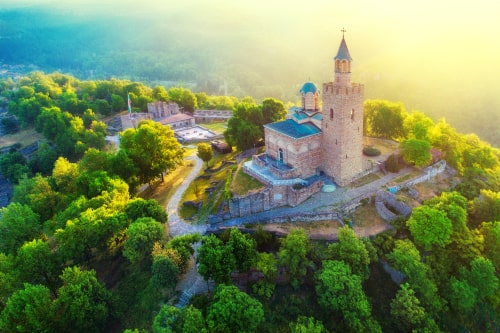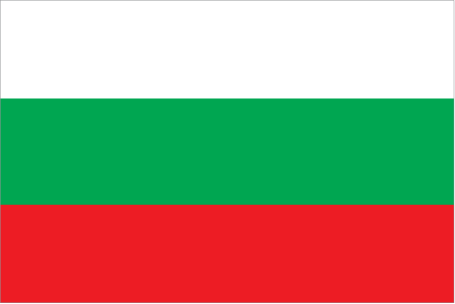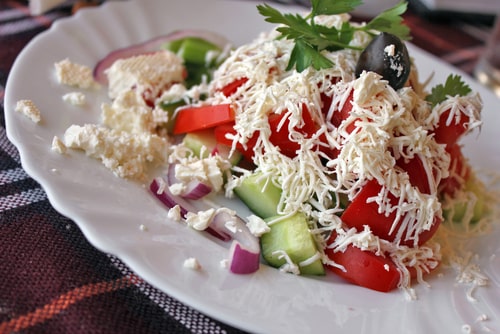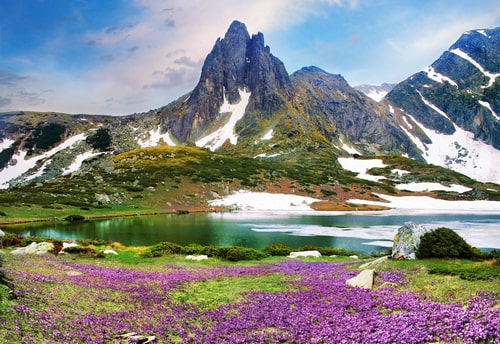Last updated on March 10th, 2020
Bulgaria, officially the Republic of Bulgaria, is a country in Southeastern Europe. It has an area of 110,879 square km. The state’s capital city is Sofia. Bulgarian is its official language. Its currency is known as Lev (BGN). It has five bordering countries that are Romania, Serbia, Republic of Macedonia, Greece, and Turkey.
Bulgaria is a land of mountains, hiking trails, ski resorts for the winter and beach resorts on the Black Sea. A blend of Western and Eastern cultures, it contains the second oldest occupied town in Europe and a relatively urban lifestyle. Frequented by Eastern European tourists, the West is only now discovering this beautiful country. Whet your appetite with these 50 facts about Bulgaria and begin to plan your own visit.
Historical facts about Bulgaria
1. Human activity in the land that is Bulgaria was present during the Paleolithic era. Animal bones carved with man-made markings have been discovered in the Korarnika cave that are assumed to be some of the earliest examples of humans’ symbolic behavior. The Hamangia, Vinča, Varna cultures were all prehistoric societies organized and living in Bulgarian lands.
2. The Varna invented gold working and were some of the first gold smelters. They produced the jewelry, coins and weapons of what is now known as the Varna Necropolis treasure found among 290 graves. This treasure is the oldest golden one in the world and is over 6,000 years old.
3. Bulgaria is one of the oldest countries in Europe and even pre-dates the Roman Empire. Founded as the Republic of Bulgaria in the 7th century, it lies at the intersection of two important trade routes — one from eastern and northern Europe to the Mediterranean Basin and one from central and western Europe to the Middle East. People and trade goods from Greece, Rome and Byzantium often traveled through Bulgaria throughout its history. The new state established the First Bulgarian Empire.

4. Paganism was abolished, the Cyrillic alphabet was adopted and a cultural golden age took place during the First Bulgarian Empire. Ended by Byzantine conquest in 1018, Boris II’s reign prevented discontent and revolts by retaining the local nobility’s rule and easing their tax burdens. Later Ivan Asen I and Peter IV led an uprising in 1185 and re-established a Bulgarian state, laying the foundations of the Second Bulgarian Empire with Tarnovo was its capital.
5. For 23 years culture and commerce flourished, then internal conflicts and outside raids diminished the empire until it ended in 1396 when it came under Ottoman rule for the next five centuries. THE Ottoman Turks eliminated the nobility and enserfed the Bulgarian people. The Enlightenment period taking place in Western Europe in the 18th century influenced the initiation of the National Awakening movement of Bulgaria. With a restored national consciousness feeding their liberation struggle, the people fought in the 1876 April Uprising. The resulting massacre of 30,000 Bulgarians led to the Constantinople Conference by the Great Powers in 1876, to whose decisions the Ottomans would not agree. Russia declared war (1877-78) and with the help of the Bulgarians, defeated the Ottomans, leading to the formation of the Third Bulgarian Empire.
6. Conflicts with its neighboring countries prompted Bulgaria to be Germany’s ally during both world wars. Bulgaria sustained territorial losses in World War I and, though aligned with the Axis powers during WWII, refused to send its Jewish population to concentration camps and saved them instead. (They were only one of two countries who did; the other was Denmark.)
7. They failed to achieve peace with the Allies and wouldn’t expel German forces when asked to by the Soviets. Consequently they were invaded by the USSR and Bulgaria became a socialist state in the Eastern Bloc.
8. Bulgaria remained a communist country until the fall of those governments in eastern Europe in the late 1980s and early 1990s. The era of post-communism led to a difficult transition into a democracy with a market-based economy.
9. Bulgaria is a member of the European Union, the Council of Europe, and NATO. It is a founding state member of the Organization for Security and Co-operation in Europe (OSCE). It has also three times taken a seat at the UN Security Council.
10. Bulgaria is the only country in the Europe whose name has not changed since the original establishment of the country (in 681 AD).
Flag of Bulgaria

Facts about Bulgarian culture, traditions and customs
11. The official language of the Bulgarian people of all ethnicities is Bulgarian and all ethnic groups speak it, either as a first or second language. It is the oldest written Slavic language and is written in the Cyrillic alphabet.
12. Bulgarians have freedom of religion; there is no official state religion. The majority of religious Bulgarians are members of the Bulgarian Orthodox Church. Religious minorities include Muslims, Christians, Jews and Gregorian Armenians.
13. The State provides education for all children in primary (1-8) and secondary (9-12) public schools. High schools students study for a technical, general, vocational or specialized discipline education before higher education. The national literacy rate is estimated at over 98 percent.

14. The food in Bulgaria has a strong Greek and Turkish influence with dishes like baklava and Shopska salad; a cucumber, onion, tomato, white cheese and pepper dish that reminds one of a Greek salad. Popular and well-known local dishes include lukanka, lyutenitsa, banitsa, and kozunak. Some Asian dishes such as gyuvech and moussaka are also popular. Because of the popularity of a wide variety of salads, meat consumption is lower in Bulgaria than the European average. Rakia is a traditional brandy and Muskat and Mavrud are two of the country’s wines. There are also many excellent varieties of local cheeses. Yogurt originated in Bulgaria and is the national food.
15. Bulgarian folk music is a highly developed traditional art in this country. A fushion of Eastern and Western influences, it achieves distinctive sounds with the use of a wide variety of traditional Bulgarian instruments, including the gadulka, the tupan, the kaval, and the gaida (bagpipe). The extended rhythmical time in Bulgarian folk music is its most distinguishing feature. It has no equal anywhere in Europe. Written musical compositions date back to the Middle Ages and the State Television Female Vocal Choice received a Grammy Award in 1990 for performing their native music.
16. The national instrument is the bagpipes, called the gaida in Bulgaria. There are only three nations in the world that employ the bagpipes in their traditional music. They are Scotland, Ireland, and Bulgaria.
17. One of the oldest Bulgarian folk traditions is the rite of fire dancing. It was practiced eons ago by the Thracians near the White Sea. Today it is still performed in only a few mountain villages of the Strandzha region. It is included as a UNESCO legacy of non-material culture. Today it is connected with celebrations for the patron saints Constantine and Elena and though done throughout the year, it is most closely practiced on June 3rd when those two saints are honored. The saints’ icons are clothed and the village processes with them to the holy spring of Saint Constantine, where their carry handles are washed. The fire is laid in a circle so everyone can observe the dance. The fire dancers go to the saints’ chapel, where they breathe incense and prepare with prayer. Musicians play three special melodies and the fire dancers enter the fiery circle after the first dancer crosses the coals in the pattern of a cross. Their dance movements are intricate and their bare feet are not burned.
18. The oldest golden treasure in the world was found from the Eneolithic period in a necropolis (graveyard) near Varna in 1972. Over 6,000 years old, it attracted the attention of scientists from all over the world. At present, 294 graves have been explored and documented and within them 3,000 golden items found. There is great diversity among them: 38 different types of items made with gold as well as copper articles and flint items, stone, silver and clay articles. These artifacts are on display in the Archaeological Museum in Varna and are frequently shown in other museums in the country and even abroad.
19. Other treasures found throughout the centuries in the country include the Valchitran Treasure (1925) of 13 vessels, the Panagyurishte Treasure (1849) of nine vessels made of pure gold, the Rogozen Treasure of 165 silver vessels dating back to the 4th century BC and Thracian king Teres’ golden mask (2004) in the Valley of the Thracian Kings. This mask may now be seen in the Archaeological Museum in Sofia.
20. Football (soccer) is the nation’s favorite sport. The Bulgarian national volleyball team is regularly featured in the Top 10 and has won numerous medals and championships.
About Bulgarian people
21. The Bulgarian people are in a demographic crisis, with negative population growth among the country’s population for more than two decades now. The birth rate overall is below the needed replacement rate. The majority of Bulgaria’s children are born to unmarried mothers.
22. According to Mensa, Bulgarians are 2nd internationally in IQ scores as well as SAT scores. Among Mensa’s smartest people in the world, the most clever woman is Bulgarian Daniela Simidchieva, who achieved an IQ score of 200.
23. Notable Bulgarian-connected inventors include John Vincent Atanasoff, who invented the first electronic digital computer from 139-1942; Peter Petro, the Bulgarian who invented the first digital wristwatch; and Facebook creator Mark Zuckerberg, who had a Bulgarian grandfather, Marko, who emigrated in 1940 and for whom he is named.
24. Famous female sports figures include: 100 meter hurdler Yordanka Donkova, whose world record time has been unbroken for 27 years now and who set four other world record times; high jumper Stefka Kostadinova whose world record has stood for 28 years, one of the oldest in modern sports, and who has set seven other world records, four indoors and three outdoors.
25. Famous male sports figures include: footballer Hristo Stoichkov, who became the first Bulgarian player to win the Ballon d’Or; English Channel marathon swimmer Petar Stoychev who set a new world record for a crossing in 2007; sumo wrestler Kaloyan Mahlyanov who became the first European to earn Japan’s ‘ozeki’ title; and Dan Kolov, the first wrestler in the world with only two losses and 1500 wins.
Fact about Sofia – Bulgaria’s capital
26. Sofia is Bulgaria’s capital city as well as the country’s largest city. It is the nation’s economic hub city and is home to more than one million Bulgarians, three times as many as the country’s second and third largest cities, Varna and Plovdiv.
27. Sofia was founded approximately 7,000 years ago at the crossroads of those two important trade routes previously mentioned. It is the second oldest city in Europe.
28. Sofia is a city with a vibrant city center; beautiful parks; many restaurants; nightclubs and bars; mineral springs ; architectural monuments; over 250 historic landmarks and many places of cultural interest.
29. Located at the base of Mount Vitosha, the mountain is a perfect day trip from Sofia for hiking and enjoying Bulgaria in all four seasons. Only 30 minutes away, Pancherevo Lake offers rowing, fishing and picnicking.
30. Located in western Bulgaria Sofia is near the Balkan region’s geographic center. It is culturally and commercially the center of Bulgaria.
Tourism and places of interest
31. There are nine natural and historical objects on the list of UNESCO World Heritage Sites as well as cultural traditions, including: the Thracian tombs in Kazanlak and Sveshtari, the Rila Monastery, the Boyana Church, the Madara Rider, the Pirin National Park, the Rock-hewn Churches of Ivanovo, the Sreburna Nature Reserve, the ancient city of Nesebar, and Thracian ritual fire-dance called Nestinarstvo.

32. Many British, German, Romanian and Russian tourists enjoy the inexpensive resorts and beaches Bulgaria has to offer. The coastal resorts of Sunny Beach and Golden Sands; the winter resorts of Borovets, Bansko, and Pamporovo; hiking in the Rila mountains and the attractions of the national capital of Sofia are the most popular destinations for visitors.
33. The ancient Roman influence on Bulgaria culture can still be found in many of the cities throughout the country. Visitors enjoy viewing the Roman baths in Varna, ruins in Sofia, and the Roman theater in Plovdiv is the mostly intact and that is still used as a venue for concerts and plays today.
34. An ancient March 1st tradition celebrates the passing of winter. Bulgarians exchange Martenitsi bracelets; these white and red woven bracelets are worn during March until the wearer sees either a blooming tree or a stork. Then they are tied to the trees to welcome springtime. This celebration is called Baba Marta (“Grandmother March”). It is not uncommon to see some of these bracelets left in trees into the summertime.
35. In addition to birthdays, “Name Days” are also celebrated in Bulgaria. A Name Day (also known as “Saints Day”) is celebrated by people named after a particular Saint on their Saint’s birthday. Many Bulgarians value their “Name Day” as much or more than their birthday.
. . . continue reading on the next page.
